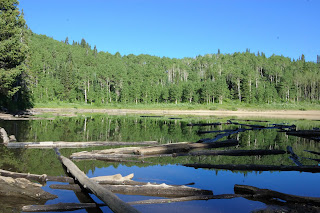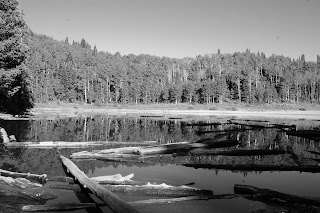There are two sides to photography, just like there are two sides to the human brain. In photography, we have the technical side which deals with the camera and how it works. Photography also has the artistic side which deals with how the picture is composed. The purpose of a camera is to help the photographer be able to express their artistic image ideas. Some cameras do it better than others. Although a point and shoot camera can take a very nice artistic image, the DSLR makes it easier to do.
We will be looking at both the technical side of Nikon Digital SLRs and how to use them to create the image we want to record.
A Light Tight BoxA camera is essentially a light tight box with a lens that can focus light reflected by or generated by objects in the world outside of the camera. On a digital camera this light is focused onto a sensor that records the light. The camera then uses firmware to interpret the digital data and create either a RAW or JPG file. Nikon DSLR cameras can create both at the same time. This sensor has a certain sensitivity to light which is measured by an ISO number. The camera can adjust the sensitivity to make it either more or less sensitive to light within the constraints of the sensor. This is what produces the various ISO values that the camera can have. The more sensitive the sensor is to light, the higher the ISO. There is a side effect to this and that is called noise. Noise causes the image to degrade. The Nikon DSLR cameras have gotten quite good at limiting the noise at higher ISO numbers. Most Nikon DSLR cameras produce acceptable images at 1600 or 3200 ISO.
ShuttersA camera also has a shutter that opens to let the light that is coming through the lens enter the camera, be recorded by the sensor, and processed by the camera, and written to the SD card. The shutter can be set to different speeds to control the amount of light that enters the camera. The side effect of the shutter is that a shorter shutter speed tends to stop motion while a longer shutter speed shows motion as a blur.
LensesThere are two types of lenses for Digital SLR cameras. Prime also known as Fixed Focal Length lenses and zoom lenses. A prime lens may be a wide angle, normal, or telephoto. Zoom lenses may also be wide angle, normal, or telephoto. The difference being that a zoom lens can be adjusted to more than one focal length. All of these lenses have an aperture which is settable to different opening sizes called f/stops. The wider the aperture, the more light that is allowed to pass through the lens, the smaller the aperture, the less light that is allowed to pass through the lens. The side effect of this is that as the aperture gets wider, less and less of the picture can appear to be in focus. As the aperture gets smaller, more and more of the picture can appear to be in focus. The reason why an area appears to be in focus is because only one point in space is actually in focus at one time. As objects are located further and further away from the point of focus, the less they are in focus. Our eyes interpret images that are of a certain degree of focus to be in focus.
MeteringSo we now have three things that determine the amount of light the camera gets and interprets. The ISO, shutter speed, and lens aperture. DSLRs have the ability to measure the amount of light they are receiving at the sensor and based upon the ISO, determine if the picture is properly exposed. This is a fairly arbitrary determination. Historically, cameras determined that a picture was properly exposed if the area being metered evaluated to the equivalent color of an 18% grey card. The Nikon DSLR still does that in spot and center weighted metering. Matrix metering basically does the same but the image is split up into sections and each section is evaluated and compared against a historical database within the camera to determine if the exposure is correct. But for our purposes we can assume that to be properly exposed a certain amount of light has to reach the sensor based upon what the camera ISO setting.
As ISO settings change they make the sensor either twice as sensitive or half as sensitive. In other words ISO 200 make the sensor twice as sensitive as ISO 100 but ½ as sensitive as ISO 400. Nikon DSLR cameras normally have the ISO values of 100, 200, 400, 800, 1500, 3200, and 6400.
As shutter speeds change they let in ½ as much light or twice as much light. For example, 1/60th of a second keeps the shutter open 1/2 as long as 1/30th of a second, but keeps the shutter open for twice as long as 1/120th of a second. This translates in more or less light entering the camera. Shutter speeds, in full exposure increments are 1, ½, ¼,1/8,1/16, 1/30, 1/60, 1/125, 1/250, 1/500, 1/1000, 1/2000, and 1/4000. Shutter speeds can also be greater than 1 second. In fact a shutter may be kept open for an arbitrary amount of time when in the bulb setting.
As apertures change they let in ½ as much light or twice as much light. For example, f/5.6 lets in twice the light of f/8 but ½ the light of f/4. F/stops follow a geometric sequence. Going from the widest opening to smallest opening, these values are: f/1, f/1.4, f/2, f/2.8, f/4, f/5.6, f/8, f/11, f/16, f/22, f/32, etc.
Since each of these three settings ISO, shutter speed, and aperture are changeable in increments, normally by 1/3, 1/2, or 1 exposure value. Changing these various values allow you to artistically control the image. However, if you want to keep the same exposure you have to change two of them at a time. One will allow more light to reach the sensor, while the other setting will reduce the amount of light that reaches the sensor by the same amount. This keeps the same amount of light hitting the sensor and keeps a proper exposure.
For example, if the proper exposure at any given ISO is 1/6oth of a second at an f/stop of f/4, then you can change the f/stop to f/5.6 and the shutter to 1/30th of a second and obtain the same exposure.
Exposure Compensation What the camera determines is proper exposure and what the photographer considers proper exposure are rarely the same. This is because of the ability of photographers to express themselves artistically. So they may want the image to be either underexposed or overexposed as far as the camera is concerned. When that is the case, you use your exposure compensation button. If you are in manual mode, the camera takes the exposure compensation into effect when showing over/under exposure in the viewfinder. For example, if the non compensated correct exposure is f/8 at 1/125 second and you add a -1 exposure compensation, then the meter will say that f/8 at 1/125 is one stop over exposed. In this example, the meter will indicate correct exposure if you have the settings at f/5.6 at 1/125 or f/8 at 1/250 second. If you are in aperture priority or shutter priority the camera will automatically adjust the shutter or aperture to get the proper compensated exposure. In manual mode whether you change it to f/5.6 at 1/125 or to f/8 at 1/250 depends on whether you want to change the depth of field or the stop action speed of the shutter.


























